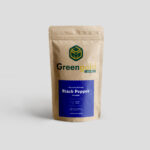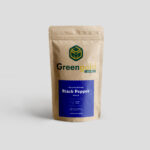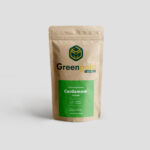Have you always wanted to grow your own black pepper but don’t have a large garden space? Good news! You can grow black pepper in containers, making it perfect for small spaces like apartments, balconies, or patios. 🌱
In this step-by-step guide, we’ll show you how to grow Piper nigrum, the plant that produces black pepper, in containers, so you can enjoy fresh, organic black pepper right from your home! 🌿✨
👉 Shop premium black pepper plants and gardening tools at Greengold Guide!
1. Why Grow Black Pepper in Containers? 🌿
Growing black pepper in containers offers several benefits, especially if you’re limited on space. Here’s why it’s a great idea:
- Portable: You can move the container around to find the best growing conditions.
- Space-Saving: Perfect for balconies, patios, or windowsills.
- Control: You can easily control soil quality, watering, and exposure to sunlight.
- Decorative: A black pepper plant is not only functional but can also add a touch of greenery to your home! 🌱
2. What You’ll Need to Grow Black Pepper in Containers 🌶️
Before you get started, make sure you have all the necessary supplies. Here’s a list of what you’ll need:
- Container: A large pot or container with a minimum size of 18-24 inches in diameter and depth. It needs to be deep enough to accommodate the plant’s root system.
- Well-Draining Soil: Use a light, well-draining potting mix. A mix designed for tropical plants works best. Add perlite or sand to improve drainage.
- Pepper Vine: You can start with a seedling, cutting, or seeds. For faster results, start with a young plant.
- Support: A trellis or stake to support the climbing vine.
- Watering Can: To water your plant regularly.
3. Choosing the Right Container 🌱
When selecting a container for your black pepper plant, keep in mind that it needs to be large enough to allow for proper root development. Pepper vines are climbing plants, so you’ll also need to provide a support system for the vine to grow upwards.
- Material: Choose a pot made of terra cotta, plastic, or ceramic. These materials help with drainage and root health.
- Drainage Holes: Ensure the container has sufficient drainage holes to prevent waterlogging and root rot.
- Size: As mentioned, the container should be at least 18-24 inches in diameter and depth. The larger, the better for root expansion.
4. Preparing the Soil 🌿
The right soil mix is crucial for healthy black pepper growth. Black pepper plants prefer rich, loamy, and well-draining soil.
Here’s how to prepare the perfect soil mix:
- Use potting soil designed for tropical plants or indoor plants.
- To improve drainage, add perlite, sand, or vermiculite.
- For extra nutrients, add compost or organic matter to the mix.
Ensure the soil is light and aerated, as heavy soils can cause water to stagnate, which can lead to root rot. 🌱
5. Planting Your Black Pepper Vine 🌿
Now, it’s time to plant your black pepper vine in the container. Follow these steps:
- Fill the container with your prepared soil, leaving about 2-3 inches from the top to avoid overflow when watering.
- Plant the seedling, cutting, or seeds:
- If planting from cuttings or seedlings, dig a small hole in the center of the pot and gently place the plant into the hole. Fill it with soil and firm it down lightly around the roots.
- If planting from seeds, sprinkle the seeds on top of the soil and lightly cover them with a thin layer of soil. Keep the soil moist until they germinate (around 3-4 weeks).
- Water the plant gently after planting, but avoid overwatering. Keep the soil consistently moist, but not soggy. 🌿
6. Providing Support for the Pepper Vine 🌱
Black pepper is a climbing vine, so it will need something to climb. Here’s how to provide support:
- Place a trellis or stakes in the container as soon as you plant your pepper vine.
- As the plant grows, gently train the vine to climb the trellis or stake.
- Use soft plant ties or twine to secure the plant to the support structure as it grows. 🌿
The vine can reach lengths of up to 10 feet or more, so make sure your support system is tall and sturdy enough to handle the growth! 🌱
7. Caring for Your Black Pepper Plant 🌿
Now that your black pepper vine is planted, it’s time to provide the best care for it to thrive. Here are some essential care tips:
Watering 💧
- Keep the soil moist but never waterlogged. Black pepper plants don’t like their roots to sit in water.
- Water when the top inch of the soil feels dry to the touch.
Light 🌞
- Bright, indirect light is ideal. A south-facing window is a great spot for your black pepper plant if you’re growing it indoors.
- Avoid placing the plant in direct sunlight, as this can burn the leaves.
Temperature 🌡️
- Black pepper plants love warm temperatures. Keep them in areas with temperatures between 75°F and 85°F (24°C to 29°C).
- Avoid drafts or places where the temperature drops below 60°F (15°C).
Humidity 💧
- Black pepper thrives in high humidity. Aim for 60% or higher humidity.
- If you’re growing the plant indoors, consider using a humidifier or placing a shallow tray of water near the plant.
Fertilizing 🌱
- During the growing season (spring and summer), feed the plant with a balanced, water-soluble fertilizer every 4-6 weeks.
- In fall and winter, reduce fertilizing as the plant’s growth slows.
8. Troubleshooting Common Issues ⚠️
As a beginner, you might face a few challenges along the way. Here are some common issues and how to address them:
Yellowing Leaves 🍂
- This could indicate overwatering or poor drainage. Make sure your container has proper drainage holes, and adjust your watering habits.
- Yellowing can also be a sign of a nutrient deficiency. Try feeding the plant with a balanced fertilizer.
Pests 🐞
- Watch for common indoor pests like aphids, mealybugs, or spider mites.
- Use organic insecticidal soap or neem oil to treat pest infestations naturally.
Slow Growth 🌱
- Ensure the plant is receiving enough light and that the soil is well-draining.
- If it’s growing too slowly, it may be time to fertilize or repot the plant into a larger container to promote root growth.
9. Harvesting Black Pepper 🌶️
After about 3-4 years, your pepper vine should start producing small green peppercorns. Here’s how to harvest:
- Wait until the peppercorns turn red and become fully ripe.
- Harvest by cutting the peppercorn clusters from the vine.
- Dry the peppercorns in the sun until they turn black and harden. Once dried, they are ready to be used in cooking!
10. Final Thoughts: Growing Black Pepper in Containers 🌱
Growing black pepper in containers is a fun and rewarding way to add fresh, organic black pepper to your kitchen. Whether you have a small balcony or a sunny windowsill, you can enjoy the satisfaction of harvesting your own peppercorns and adding them to your favorite dishes! 🌶️
With the right care, patience, and attention, your black pepper vine will thrive and produce delicious, homegrown pepper for years to come. 🌿
👉 Shop black pepper plants and more gardening tools at Greengold Guide!


